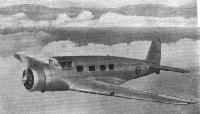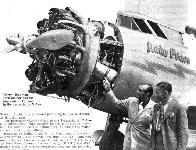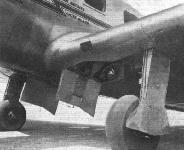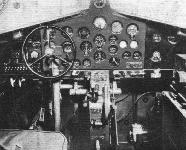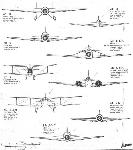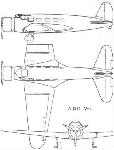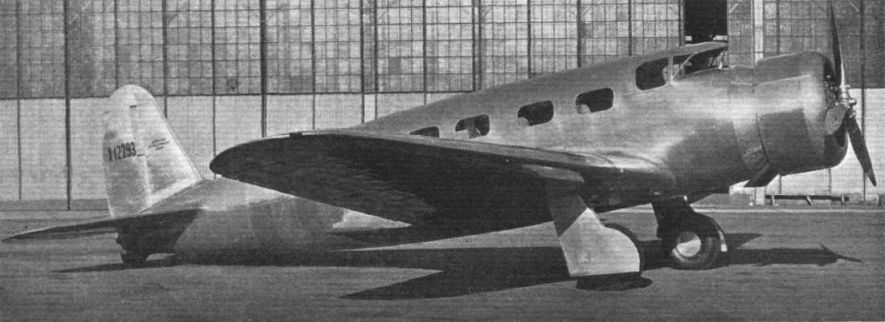
Vultee V-1A
Прототип самолета Vultee V-1 спроектировал Джерард И. Валти, а построила компания «Airplane Development Corporation». Это был цельнометаллический моноплан с работающей обшивкой, вмещавший летчика и шестерых пассажиров. Новинка того времени - убираемое шасси - обеспечила в числе прочего высокие результаты летных испытаний, которые начались 19 февраля 1933 года.
Серийные V-1A отличались от прототипа более широким и длинным фюзеляжем и экипажем из двух человек; пассажировместимость доведена до восьми человек. Серийные машины оснащались мотором Wright SR-1820-F2 Cyclone мощностью 750 л. с. (559 кВт). До окончания серийного производства в начале 1936 года было построено 24 V-1A.
Прототип V-1 (доработанный под экипаж из двух летчиков) и восемь V-1A приобрела в 1934 году авиакомпания «American Airlines», но через два года продала их, перейдя на эксплуатацию исключительно двухмоторных самолетов. Большинство V-1A использовались мелкими компаниями и частными лицами.
Размах крыла V-1A составлял 15,24 м, максимальная скорость - 362 км/ч, дальность полета - 1609 км.
Один V-1A с поплавковым шасси был закуплен Советским Союзом. Еще один аналогичный самолет использовался в попытке выполнить первый перелет Нью-Йорк - Лондон - Нью-Йорк; позже эту машину использовали испанские националисты. Семь самолетов, ранее летавших в «American Airlines», в годы гражданской войны в Испании использовали республиканцы. Эти V-1A получили вооружение из четырех-пяти пулеметов, под фюзеляжами установили бомбодержатели. В боевых действиях самолеты участвовали ограниченно, четыре самолета в конечном итоге попали к франкистам.
Описание:
- Vultee V-1A
- Flight, March 1934
THE AIRPLANE DEVELOPMENT CORPORATION “V.I" - Flight, October 1935
TWO AMERICAN MONOPLANES
Фотографии
-
История Авиации 2001-06 / И.Гордельянов, М.Жирохов - Американские пилоты в Гражданской войне в Испании /В небесах мы летали одних/
V1A из состава 1-й эскадрильи 72-й смешанной авиагруппы республиканских ВВС. Аэродром Лос Альказарес, сентябрь 1937г. В перегонке этих самолетов участвовал Винсент Шмидт.
-
Flight 1934-03 / Flight
Регистрационный номер: X12293 [2] FOR HIGH-SPEED TRANSPORT: The Airplane Development Corporation V-1 three-quarter front view.
-
Мировая Авиация 9
Регистрационный номер: X12293 [2] 19 февраля 1933г.: Первый полет Vultee V-1A - типичного самолета авиапромышленности того времени с работающей обшивкой и убираемым шасси.
The original V-1 prototype (X12293) in its initial form. Note rake of mainwheel legs, three-blade airscrew, long-chord cowling, and small vertical surfaces. -
Air International 1987-03 / R.Braybrook - The Sixties, the Thirties and the American Challenge
Регистрационный номер: NC13768 The fifth production V-1A (NC13768) delivered to American Airlines in the autumn of 1934.
The Lockheed Orion and Vultee V-1a were among the advanced single-engine low-wing designs that demonstrated the ability of the US aircraft industry to achieve good ratios of useful load to max take-off weight in the mid-thirties. -
Мировая Авиация 250
Регистрационный номер: NC16099 [4] V-1A являлся достаточно «продвинутым» для своего времени самолетом, особенностями конструкции были работающая обшивка и убираемое шасси. Максимальная взлетная масса составляла 3856 кг.
The last production V-1A (NC16099) as originally delivered to William Randolph Hearst. -
Air Enthusiast 1972-07 / ??? - Those versatile Vultees
One of the seven ex-American Airlines V-1As originally acquired by the Spanish Republican government and four of which survived the Civil War to enter Nationalists service as illustrated.
-
Air Pictorial 1957-01 / Air Pictorial's photo-review
Регистрационный номер: NC16099 [4] TWENTY-ONE·YEAR OLDS. This Gerald Vultee designed and built eight-seat Model V-1A (with Panamanian letters HP158) dates from 1935/36 when, it is believed, it was owned by Hearst Publications Inc. (NC16099; construction number 25) and used as an executive transport.
-
Air Enthusiast 1972-07 / ??? - Those versatile Vultees
Регистрационный номер: NC16099 [4] The last production V-1A (NC16099) with the Panamanian registration (HP-158) as it appeared in the film "Jungle Queen".
-
Flight 1935-07 / Flight
Регистрационный номер: NC13767 A Vultee of American Airlines. The same type is also used by Bowen Air Lines from Brownsville to Fort Worth. This machine is probably the fastest on any scheduled air line in the world
-
Air Enthusiast 1972-07 / ??? - Those versatile Vultees
Регистрационный номер: NC16099 [4] The last production V-1A (NC16099). This aircraft, now the sole remaining example of its type and fully restored, illustrated as flying at the present.
-
Air Enthusiast 1972-07 / ??? - Those versatile Vultees
When originally obtained by the Spanish Republicans, the ex-American Airlines V-1As were adapted for the attack bombing role, the example illustrated by these photograph being one of those fitted with a dorsal gun position aft of the pilots' compartment. Additional machine guns were mounted in the wings and above the nose.
-
Air Enthusiast 1972-07 / ??? - Those versatile Vultees
When originally obtained by the Spanish Republicans, the ex-American Airlines V-1As were adapted for the attack bombing role, the example illustrated by these photograph being one of those fitted with a dorsal gun position aft of the pilots' compartment. Additional machine guns were mounted in the wings and above the nose.
-
Авиация и Время 2000-06 / М.Маслов - История одного приобретения /Аэроархив/
Регистрационный номер: СССР-Н208 [2] H-208 заходит на посадку на реке Лена
-
Авиация и Время 2000-06 / М.Маслов - История одного приобретения /Аэроархив/
Регистрационный номер: СССР-Н208 [2] H-208 на аэродроме в Свердловске 13 сентября 1936г.
-
Flight 1935-11 / Flight
A VULTEE IN ENGLAND: The demonstration Vultee, which has been sent over here by Mr. Cord, being flown last Monday by Mr. Lee Smith at Hanworth, where it is being housed.
-
Авиация и Время 2000-06 / М.Маслов - История одного приобретения /Аэроархив/
Самолет "Валти" над Калифорнией
-
Flight 1935-10 / Flight
CRUISING AT 215 M.P.H.: The latest V1-A Vultee commercial machine flying above the clouds of Southern California.
-
Flight 1935-11 / Flight
CYCLONIC: Mr. Lee Smith and the demonstration Vultee which, with a Wright Cyclone F. engine of 750 h.p., has a maximum speed of 235 m.p.h.
-
Flight 1936-09 / Flight
Harry Richman, Dick Merrill and the impressive Cyclone in the transatlantic Vultee.
-
Flight 1934-03 / Flight
A MODERN UNDERCARRIAGE: One-half of the retractable undercarriage. The tail wheel also is retractable.
-
Flight 1935-10 / Flight
This view shows the Vultee's retractable undercarriage, with one of the wheel wells and automatically closing cover. Note also the concealed landing light and, on the leading edge, the indirect ventilation intake.
-
Авиация и Время 2000-06 / М.Маслов - История одного приобретения /Аэроархив/
С.Леваневский выглядывает из кабины своего "Валти"
-
Flight 1934-10 / Flight
A MODERN "CONTROL ROOM": The cockpit of the single-engined Vultee V-1A, which cruises at 215 m.p.h. The usual instruments for normal and blind flying can be seen, as well as the airscrew pitch adjustment, and the flap and undercarriage retraction controls.
-
Авиация и Время 2000-06 / М.Маслов - История одного приобретения /Аэроархив/
Пассажирская кабина, туалет и приборная доска "Валти" V-1
-
Flight 1934-10 / Flight
Другие самолёты на фотографии: Airspeed Viceroy / AS.8 - Великобритания - 1934Beechcraft Model 17 Staggerwing - США - 1932Bleriot Bleriot-111 - Франция - 1929British Klemm BK-1 Eagle - Великобритания - 1934Caproni Bergamaschi PL-3 - Италия - 1934De Havilland Dragon Rapide / Dominie / D.H.89 - Великобритания - 1934Vance Flying Wing / Viking Cargo Plane - США - 1932
-
Flight 1934-03 / Flight
A.D.C. V-I
-
Air Enthusiast 1972-07 / ??? - Those versatile Vultees
The general arrangement drawing illustrates the standard production V-1A, the upper sideview illustrating the original V-1 prototype.
- Фотографии

















